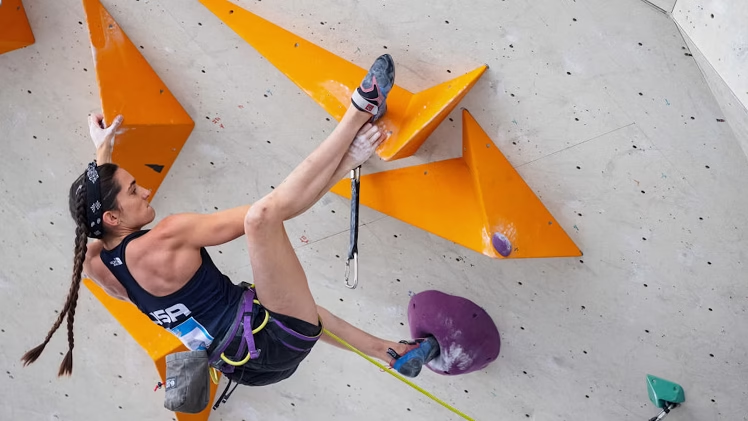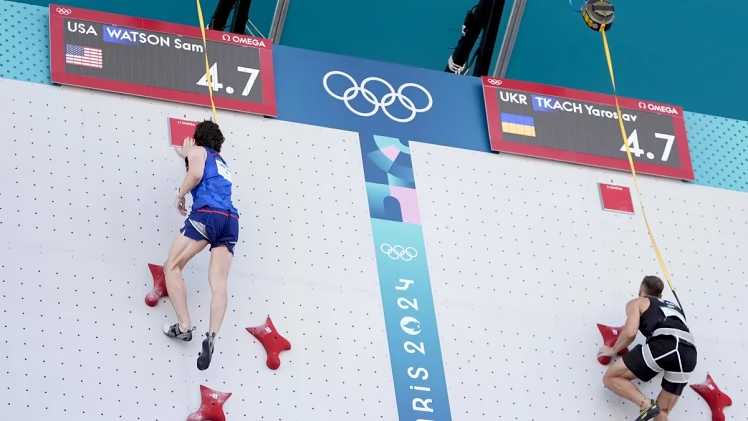Over the past few decades, sport climbing has become much more popular, and its involvement in the Olympic Games has elevated the sport to a global level of awareness. In this comprehensive guide, we’ll take a deep dive into the Sport Climbing Combined Olympics, explaining everything from its history, competition format, and rules to its significance and the future of the sport in the Olympic context.
What is Sport Climbing?
Sport climbing is a discipline of rock climbing where athletes use fixed anchors and other artificial holds to ascend vertical or near-vertical rock walls. Depending on the competition, the objective is either to reach the highest point or finish the climb in the least amount of time.
There are three primary disciplines in sport climbing:
Lead climbing: Athletes climb a route that increases in difficulty as they ascend. They must clip into fixed anchors along the way. The climber who reaches the highest point or the end of the route wins.
Bouldering: Climbers tackle shorter, but more difficult routes (called “problems”) without the use of ropes. The emphasis is on power, strength, and technique. The climber who completes the most problems in the least amount of time wins.
A race to the top of a standardized wall is known as speed climbing. The climbers start simultaneously and the first to reach the top wins.
These three disciplines were initially treated as separate events in climbing competitions. However, for the Tokyo 2020 Olympics, the International Olympic Committee (IOC) decided to combine them into one event.
Also Read: blogsternation .com
The History of Sport Climbing in the Olympics
It has taken a while for sport climbing to be added to the Olympic program. Although the sport has existed for over a century, it wasn’t until the late 20th century that it began to gain widespread recognition. Climbing has been a part of the World Games and World Championships since the 1980s, but its Olympic debut happened in 2020.
Initially, there were discussions of making climbing a permanent fixture in the Summer Olympics, but it wasn’t until 2016 that the IOC officially announced that it would be added to the Tokyo 2020 Games. This was part of the IOC’s effort to modernize the Olympic Games by adding newer, more youth-oriented sports.
For the Tokyo 2020 Olympics, climbing was introduced in a combined format, meaning that athletes would compete in all three disciplines—lead climbing, bouldering, and speed climbing—in one event. This created a unique challenge for climbers, who had to excel in different aspects of the sport.
Also Read: Top Strategies for Winning
Understanding the Sport Climbing Combined Format
In the Sport Climbing Combined format, athletes compete in all three disciplines: lead climbing, bouldering, and speed climbing. The results from all three events are combined into a single score, with the athlete having the lowest total score being crowned the winner.
Each discipline contributes to the final score:
Lead climbing: Athletes are ranked based on how high they climb, with the climber reaching the highest point scoring the fewest points. If a climber doesn’t finish, they are given a higher score, reflecting the difficulty of the climb.
Bouldering: The climber’s performance is measured by the number of problems they successfully complete. A problem’s score decreases with the number of attempts required to solve it.
Speed climbing: In this event, athletes compete in a timed race. The fastest climber wins, with the slowest receiving a higher score.
The combined score from all three disciplines determines the overall placement. This format aims to showcase a climber’s versatility, as they must excel in all areas to be successful.
Key Rules and Regulations of the Combined Event

In order to ensure fairness and consistency, there are several important rules and regulations that athletes must follow during the Sport Climbing Combined event. Here are some key aspects:
Scoring System:
The climbers are ranked in each of the three events (lead, bouldering, and speed). The combined score is the sum of their rankings in each event.
The climber with the lowest combined score is crowned the Olympic champion.
Tie-Breaking:
If two climbers have the same combined score, a tie-breaker is used. The athlete who has the best performance in the lead climbing discipline usually breaks the tie.
Safety Standards:
All climbing walls used in competitions must meet strict safety regulations to ensure the safety of the athletes. In speed climbing, for example, the wall is standardized and measured to ensure fair competition.
Time Limits:
In speed climbing, climbers must race to the top of a 15-meter wall in the fastest time possible. Athletes in lead climbing have a certain length of time to climb the wall.
Judging:
The performance of the climbers is judged by a panel of expert officials. In bouldering and lead climbing, the judges assess the climber’s performance based on the number of attempts and the difficulty of the moves.
Challenges and Opportunities for Athletes
The combined format of Olympic sport climbing presents several challenges for athletes. Here are some of the key challenges and opportunities they face:
Challenges:
Versatility:
Athletes must excel in all three disciplines. Lead climbers may struggle with speed climbing, while boulderers may need to improve their endurance for lead climbing.Physical Demands:
The sport requires both explosive strength (for bouldering and speed climbing) and endurance (for lead climbing). Balancing these two types of physical demands is tough for athletes.Psychological Pressure:
Competing in all three disciplines in one event can be mentally taxing. Athletes must remain focused throughout, with little room for error.
Opportunities:
Global Exposure:
Being part of the Olympics gives climbers a platform to showcase their skills to a global audience, inspiring new generations of climbers.Cross-Disciplinary Growth:
Athletes who excel in one discipline can improve their performance in others. Athletes are encouraged to acquire a wider variety of skills by the Olympic format.
Why the Combined Format?
The decision to combine the three disciplines into a single Olympic event was made to increase the visibility and excitement of sport climbing. It also reflects the broader trend in Olympic sports to streamline events and appeal to a younger, more diverse audience.
The combined format ensures that climbers are versatile, offering a more comprehensive assessment of an athlete’s abilities. This makes the competition even more thrilling for spectators, as climbers are pushed to perform across different aspects of climbing.
The Future of Sport Climbing in the Olympics
Sport climbing’s future in the Olympics looks bright. The sport, which made its debut at the 2020 Tokyo Games, was added to the 2024 Olympic Games in Paris, where it will continue to enthrall spectators everywhere. Its appeal to a younger demographic and its potential for growth make it a valuable addition to the Olympic program.
In the future, it’s likely that the combined format will remain, as it adds an exciting challenge for athletes and an engaging spectacle for viewers. As climbing gyms proliferate and more youth take up the sport, we can expect a continued evolution of the athletes’ skills, pushing the boundaries of what’s possible in competition.
Frequently Asked Questions (FAQ)
1. What is the Sport Climbing Combined Olympics format?
The Sport Climbing Combined Olympics format combines three climbing disciplines—lead climbing, bouldering, and speed climbing—into one event. Athletes are ranked based on their performance in each discipline, with the lowest combined score determining the winner.
2. How are the results calculated in the combined event?
Athletes are ranked in each of the three disciplines (lead, bouldering, and speed climbing). Their rankings are then added together to form a total score. The winner is the athlete with the lowest overall score.
3. Why is sport climbing included in the Olympics?
Sport climbing was added to the Olympics to bring in more youth-oriented, exciting sports. The sport’s increasing popularity and its ability to appeal to global audiences made it a good fit for the Olympic program.
4. Which countries excel in sport climbing?
Countries like Japan, the United States, France, and Austria have produced some of the world’s top sport climbers, with athletes from these countries frequently dominating international competitions.
5. What is the significance of the combined format for athletes?
The combined format tests an athlete’s versatility, requiring them to perform in all three disciplines. This makes it more challenging but also highlights a climber’s overall skill set, rather than just excelling in one area.
6. Is sport climbing popular worldwide?
Yes, sport climbing is growing in popularity worldwide, especially in countries with strong climbing cultures. The sport has seen an increase in participation, partly due to its Olympic inclusion.
Conclusion
The inclusion of sport climbing in the Olympics, particularly in its combined format, has brought a fresh and exhilarating dynamic to the Games. The combined format pushes athletes to demonstrate their adaptability, stamina, and mental toughness across many disciplines by combining lead climbing, bouldering, and speed climbing into a one event. This not only tests their physical capabilities but also their ability to adapt and excel under pressure.
As the sport grows in popularity worldwide, the Olympic platform continues to elevate climbing athletes, inspiring future generations to take up the sport. With a global audience now watching their every move, climbers have an opportunity to reach new heights—both literally and figuratively. The future of sport climbing in the Olympics is undoubtedly bright, and the combined event is set to remain an exciting and integral part of the Games, pushing the boundaries of what athletes can achieve in this thrilling sport.
Whether you’re a climbing enthusiast or new to the sport, the Olympic combined format offers a captivating display of athleticism, precision, and perseverance that is sure to inspire all who watch.







